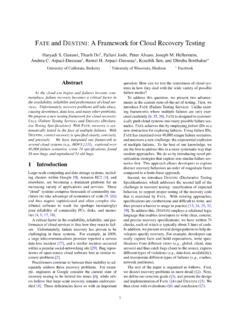Transcription of Architecture of a Database System
1 Foundations and Trends R. in Databases Vol. 1, No. 2 (2007) 141 259. c 2007 J. M. Hellerstein, M. Stonebraker and J. Hamilton DOI: Architecture of a Database System Joseph M. Hellerstein1 , Michael Stonebraker2. and James Hamilton3. 1. University of California, Berkeley, USA, 2. Massachusetts Institute of Technology, USA. 3. microsoft Research, USA. Abstract Database Management Systems (DBMSs) are a ubiquitous and critical component of modern computing, and the result of decades of research and development in both academia and industry. Historically, DBMSs were among the earliest multi-user server systems to be developed, and thus pioneered many systems design techniques for scalability and relia- bility now in use in many other contexts.
2 While many of the algorithms and abstractions used by a DBMS are textbook material, there has been relatively sparse coverage in the literature of the systems design issues that make a DBMS work. This paper presents an architectural dis- cussion of DBMS design principles, including process models, parallel Architecture , storage System design, transaction System implementa- tion, query processor and optimizer architectures, and typical shared components and utilities. Successful commercial and open-source sys- tems are used as points of reference, particularly when multiple alter- native designs have been adopted by di erent groups.
3 1. Introduction Database Management Systems (DBMSs) are complex, mission-critical software systems. Today's DBMSs embody decades of academic and industrial research and intense corporate software development. Database systems were among the earliest widely deployed online server systems and, as such, have pioneered design solutions spanning not only data management, but also applications, operating systems, and net- worked services. The early DBMSs are among the most in uential soft- ware systems in computer science, and the ideas and implementation issues pioneered for DBMSs are widely copied and reinvented.
4 For a number of reasons, the lessons of Database systems architec- ture are not as broadly known as they should be. First, the applied Database systems community is fairly small. Since market forces only support a few competitors at the high end, only a handful of successful DBMS implementations exist. The community of people involved in designing and implementing Database systems is tight: many attended the same schools, worked on the same in uential research projects, and collaborated on the same commercial products. Second, academic treat- ment of Database systems often ignores architectural issues.
5 Textbook presentations of Database systems traditionally focus on algorithmic 142. Relational Systems: The Life of a Query 143. and theoretical issues which are natural to teach, study, and test . without a holistic discussion of System Architecture in full implementa- tions. In sum, much conventional wisdom about how to build Database systems is available, but little of it has been written down or commu- nicated broadly. In this paper, we attempt to capture the main architectural aspects of modern Database systems, with a discussion of advanced topics. Some of these appear in the literature, and we provide references where appro- priate.
6 Other issues are buried in product manuals, and some are simply part of the oral tradition of the community. Where applicable, we use commercial and open-source systems as examples of the various archi- tectural forms discussed. Space prevents, however, the enumeration of the exceptions and ner nuances that have found their way into these multi-million line code bases, most of which are well over a decade old. Our goal here is to focus on overall System design and stress issues not typically discussed in textbooks, providing useful context for more widely known algorithms and concepts. We assume that the reader is familiar with textbook Database systems material ( , [72] or [83]).
7 And with the basic facilities of modern operating systems such as UNIX, Linux, or Windows. After introducing the high-level Architecture of a DBMS in the next section, we provide a number of references to back- ground reading on each of the components in Section Relational Systems: The Life of a Query The most mature and widely used Database systems in production today are relational Database management systems (RDBMSs). These systems can be found at the core of much of the world's application infrastructure including e-commerce, medical records, billing, human resources, payroll, customer relationship management and supply chain management, to name a few.
8 The advent of web-based commerce and community-oriented sites has only increased the volume and breadth of their use. Relational systems serve as the repositories of record behind nearly all online transactions and most online content management sys- tems (blogs, wikis, social networks, and the like). In addition to being important software infrastructure, relational Database systems serve as 144 Introduction Fig. Main components of a DBMS. a well-understood point of reference for new extensions and revolutions in Database systems that may arise in the future. As a result, we focus on relational Database systems throughout this paper.
9 At heart, a typical RDBMS has ve main components, as illustrated in Figure As an introduction to each of these components and the way they t together, we step through the life of a query in a Database System . This also serves as an overview of the remaining sections of the paper. Consider a simple but typical Database interaction at an airport, in which a gate agent clicks on a form to request the passenger list for a ight. This button click results in a single-query transaction that works roughly as follows: 1. The personal computer at the airport gate (the client ) calls an API that in turn communicates over a network to estab- lish a connection with the Client Communications Manager of a DBMS (top of Figure ).
10 In some cases, this connection Relational Systems: The Life of a Query 145. is established between the client and the Database server directly, , via the ODBC or JDBC connectivity protocol. This arrangement is termed a two-tier or client-server . System . In other cases, the client may communicate with a middle-tier server (a web server, transaction process- ing monitor, or the like), which in turn uses a protocol to proxy the communication between the client and the DBMS. This is usually called a three-tier System . In many web- based scenarios there is yet another application server tier between the web server and the DBMS, resulting in four tiers.







